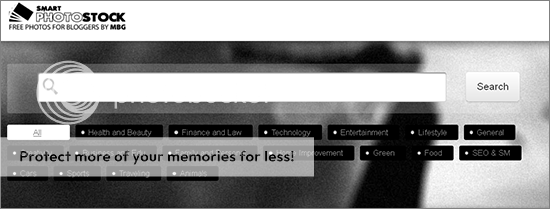The internet is a basically textual realm, with words sufficing to make most points, both technical and otherwise, but as every good blogger knows, adding a visual touch to your articles is crucial in making them attractive enough to hold the attention of fleeting visitors. Of course, the web is full of imagery, much of it free to use, that can help you to achieve this, but choosing the right images is what will set your blog apart from the competition.
Make your published content stand out from the crowd by giving your readers something to look at; here are six blogger guidelines for illustrating your posts:
1. Respect Copyrights
The web made be chock full of images that are only a click away thanks to services like Google Image Search, but that doesn’t mean that they’re simply free for the taking! The vast majority of images found online are copyrighted by someone somewhere, and you’d do well to respect that fact by ensuring that you are only utilizing those that offer you the legal right to do so. Luckily, there are thousands of images available to be used for free, whether found on a free stock photo website or obtained via a license agreement.
Besides establishing yourself as a good netizen, avoiding using copyrighted images in your content will also allow you to bypass the risk of a cease and desist letter – or even a lawsuit.
2. Choose a Favorite Royalty-Free Stock Photo Provider

Speaking of free stock photo websites, you should consider picking a favorite or two and referring to them consistently when you need that perfect image to illustrate your latest blog post. Websites like the premium SmartPhotoStock.com are wonderful resources for your blogging needs, allowing you to choose from thousands of absolutely free stock photos that cover just about every topic that you can imagine.
By utilizing a good free source for stock photos, you can always rest well knowing that you’ve got all of the graphical ammunition that you’ll ever need at your disposal – a comforting thought for any blogger, to be certain!
3. Be Sure Your Images Represent Your Topic Well
While it’s easy to write a blog post about computers and then throw in any old picture of a computer in order to add flair, you’d do your readers a much better service by being selective enough to find a photo that truly represents your topic and its angle. For example, if you mention only one or two computer models in particular in the article that we’re using as an example, be sure to use a photograph of one or both of them in particular, allowing your readers to visualize exactly what they’re reading about, and setting yourself apart as a purveyor of information that is on-point, both textually and visually.
4. Be Creative, But Not Abstract
Being creative in matching up visual elements to your written content is key, and the images that you choose to illustrate your posts give you an excellent opportunity to show off the fact that you’ve got some creative chops even when words aren’t in play. This show of creativity will help readers to better appreciate what you’ve got to offer
On the other hand, getting too creative can lead you to make an abstract choice in imagery, potentially confusing your readers if the link between the text and the image isn’t as clear to them as it is to you. Instead of feeding your own inside line of thinking, be sure to choose your blog illustrations based on what you know your readers will appreciate and enjoy, allowing them to make connections on their own, but never making that task a difficult one for them.
5. Own Your Imagery
Thanks to tools such as the popular Skitch from the same team that brought us Evernote, it is easier than ever to customize images of all kinds in order to really make them your own, allowing you to have your blog post illustrations stand out even if the picture in question originated on a free stock photo website. Allowing you to mark up, add annotations, and perform a myriad of other customizations on an image, Skitch is only one example of the many programs that will allow you to put your own personal touch on any graphic that you’re working with, including many professional image editing offerings, helping you to offer something fresh and new to your readers – even if it’s really not all that fresh and new at all.
6. Give Credit Where Credit is Due
No matter where you get your images, consider linking back to the owner, even if they originated on a free stock photo website. Besides allowing you to expose your content to the owners of those websites, you’ll also instantly make yourself a good member of the blogging community by giving credit where it is due, setting yourself up to receive the same treatment in the future. Everybody loves an honest blogger, after all!

I’m glad copyright was mentioned here – all to often I see bloggers who just grab a relevant image from a Google Images search without any thought to who it belongs to or what rights they have to using it!
Kostas, you are absolutely right. That is the real problem of blogosphere. Not all bloggers are conscious of the crime against intellectual property they are committing. We are all the part of huge community so let’s be friendly, professional, and fair with each other.
Thanks for the wonderful tips.
Thanks a lot Arup. That’s very inspiring
I enjoy reading your wonderful tips! Using art clips is a biggie. Making sure you always give credit were is due and giving image credit is a must. Many people just grab an image from Google Search with out giving the credit. Thanks will be sharing this tips with my blogger community.
Thanks Nancy. You are right. Giving image credit should de a must to every blogger. It’s a very good habit.
Hi Anna,
I have a question here, What if pictures are used for a blog that is not promoting any business or have any kind of advertisements on it? Can such a blog face lawsuit even though it is not making any kind of money from those images?
Just a curious question here!
Thanks
Piyush
Piyush, I don’t think that the fact of making money from the image matters in this case. This photo can be an intellectual property of a person or a company. So using such an image without special rights on it is lawbreaking.
My favorite resource for finding royalty free pictures to use for my blog posts is Flickr. Have to be careful though and make sure you are only searching for pictures with creative commons licenses that do allow editing. Also, might want to consider whether or not they allow you to use it for commercial use or not (depending on your type of website).
Thanks for pointing out the Skitch app (or program?) – I love Evernote, so I’ll definitely have to check that out.
Matthew, I love Evernote too. It’s very handy for me. And I’m sure you’ll like Skitch as well. It’s very simple in use and effective in getting out a message you want to deliver to your audience.
And I agree with you about the Flickr. You always should check out the license properly
hi this was a decent post regarding blogger guidelines for illustrating various and different articles in some posts
Hi Vishvast. I totally agree with you. These are flexible guidelines which can be applied in different niches
I am not able to find copyright free images for my blog. I would be really thankful if you could provide me with a list of sites that offer free images that can be used for commercial purposes.
Thanks in advance.
Mayank, as for me I usually use images from SmartPhotoStock.com. You can also check photos on Flickr, Pixabay, FreeDigitalPhotos. But don’t forget to make sure that the license fits your purpose
Thanks for the awesome tips.
Thanks Hammad. Always glad to share some helpful stuff.
Great Tips Anna ..
I saw this Post yesterday but due to Shortage of time I could not read it. Today i have read it Carefully . It’s too much Interesting & Useful Post.
These Tips are very useful to being a Successful Blogger. The more we can make our site popular with these tips. Thank you Ana for giving us that much Good Opportunity to know these useful tips .
Well, I want to keep In touch with your Every new update, So what should I do for this ?
Great tips Anna,
My strategy is always be creative, i think make your blog have a good quality and different from the others also will keep your blog last stand. Those tips will be helpful for all bloggers.
Thanks for your informative article.
Stephan
Thanks Stephan. Very good idea. Creativity is probably the main key for reaching success not only in blogging but in each aspect of our lives. So stick with this strategy and you’ll succeed!
Thanks Aqib. Your opinion makes much value to me and motivates me a lot. You can subscribe for iTechCode updates and also check for new posts on my blog manifestconnection.com. And of course I’ll be glad to connect with you on Twitter ( @manifestcon ), Facebook and Google+.
These days the most important thing is giving credit to the reader for its work. Many new bloggers and content marketers are forgetting this. Hope they will read this awesome guest post from Ana and understand what guidelines they should follow for being a pro blogger.
Hi Anna,
Thanks for the share. Never realized that many of the royalty free stock images could be
marked up with text to increase their usefulness. I Always try to give credit where credit is due,
even when using photos from free sites.
Editing and adding text is a chore I don’t adore! Will check out your Skitch and see if it works
a little easier!
Hi Cararta. You are giving great example. Giving credit to all photos (no matter free or not free) is a friendly etiquette. I hope you’ll find Skitch useful. It can add new possibilities to creativity in illustrating your blog posts.